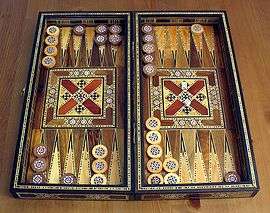Mehen (game)
Mehen is a board game which was played in ancient Egypt. The game was named in reference to Mehen, a mythological snake-god.
History
Evidence of the game of Mehen is found dating from approximately 3000 BC and continues until 2300 BC. Some of the best evidence appears during the Old Kingdom, in a picture in the tomb of Hesy-Ra. It is depicted in tombs of about 700 BC, but the board seems to have been misinterpreted as a vase, presumably because an Old Kingdom relief was copied by someone not familiar with the game.
It is known that the board depicts a game rather than being a religious object due to studies of paintings in tombs, and gameboards and equipment found. None of the associated objects fit neatly within the segments of the snake. The rules and gameplay of Mehen are entirely unknown.
Equipment

The gameboard depicts a coiled snake whose body is divided into rectangular spaces. Several boards have been found with different numbers of segments, without distinguishing marks or ornamentation. The variability suggests that the number of segments was of little importance to the game. Objects associated with the board may or may not be playing pieces. From archaeological evidence, the game seemed to have been played with lion- or lioness-shaped pieces, in sets of three or as many as six, and a few small spheres (marbles or balls).
See also
References
- Piccione, Peter A. (1991). Mehen, Mysteries and Resurrection. pp. 43–52.
- Rothöhler, Benedikt (1997). Ägyptische Brettspiele außer Senet, unveröffentlichte MA-Thesis. Philosophische Fakultät I der Bayerischen Julius-Maximilians-Universität, Würzburg. pp. 10–23. pdf file
- Tyldesley, Joyce A. (2008). Egyptian Games and Sports (= Shire Egyptology, Band 29). Osprey Publishing. pp. 15–16. ISBN 0747806616.
- Tyldesley, Joyce A. (2010). The Penguin Book of Myths and Legends of Ancient Egypt. Penguin UK, Oxford. pp. 92–93. ISBN 014196376X.
